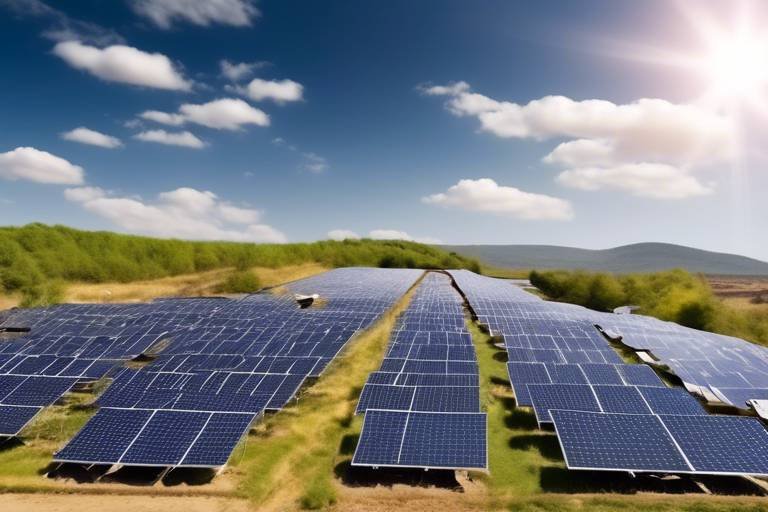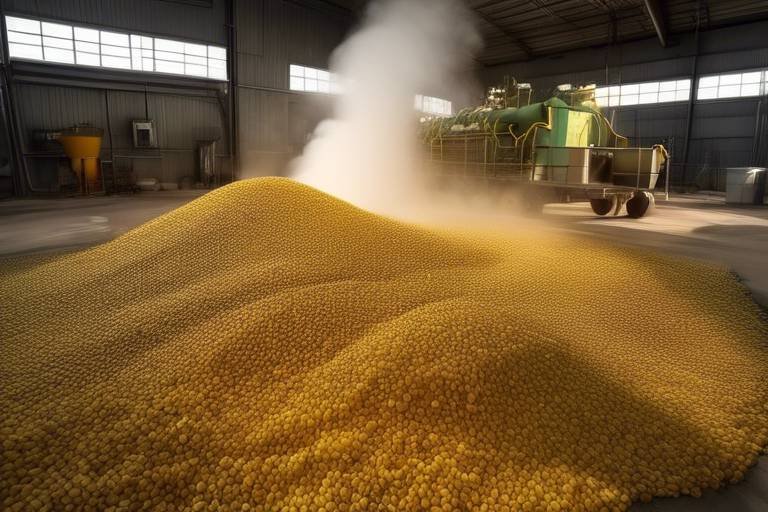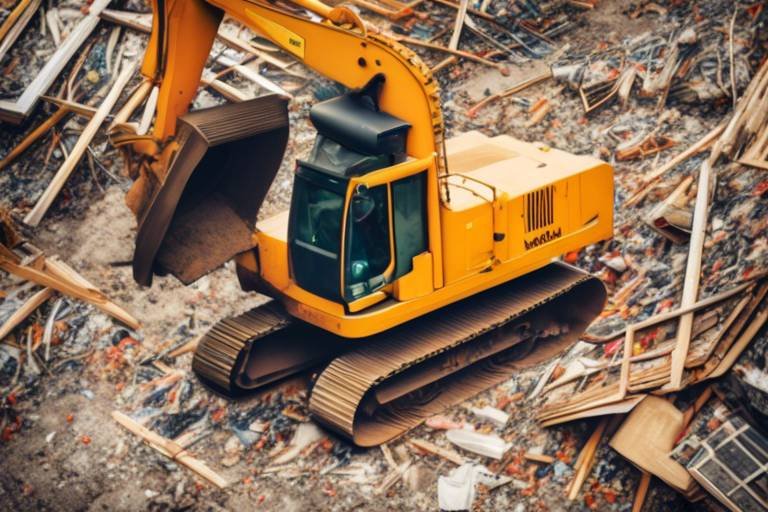The Role of Composting in Reducing Greenhouse Gas Emissions
Composting is not just a trendy word thrown around by eco-warriors; it’s a powerful tool in the fight against climate change. Imagine a world where organic waste doesn’t just rot away in landfills, releasing harmful gases into the atmosphere but instead transforms into rich, fertile soil that nourishes our planet. This is the magic of composting! By reducing greenhouse gas emissions through effective waste management, composting plays a crucial role in creating a sustainable future. Let’s dive deeper into how composting works, its benefits, and how you can get involved!
Greenhouse gases (GHGs) like carbon dioxide, methane, and nitrous oxide are the culprits behind global warming. They act like a blanket around the Earth, trapping heat and causing the planet's temperature to rise. But where do these gases come from? A significant portion originates from organic waste decomposing in landfills. When this waste breaks down anaerobically (without oxygen), it produces methane—a gas that is over 25 times more potent than carbon dioxide in trapping heat over a 100-year period. By composting our organic waste, we can mitigate these emissions and contribute to a healthier planet.
So, how does composting actually work? It’s a natural process that transforms organic materials like food scraps, yard waste, and even paper into nutrient-rich compost. The process involves several stages, including:
- Collection: Gather your organic waste.
- Decomposition: Microorganisms break down the materials, aided by oxygen and moisture.
- Humification: The compost matures into a stable state, rich in nutrients.
Throughout this process, composting not only reduces the volume of waste sent to landfills but also significantly curtails greenhouse gas emissions. Picture this: instead of releasing methane, composting allows organic materials to break down aerobically, producing carbon dioxide, which is far less harmful in terms of GHG impact.
When it comes to composting, there’s no one-size-fits-all approach. Different methods cater to various needs and resources. Here are a few popular types:
- Aerobic Composting: This method requires oxygen and is the most common. It involves turning the compost pile to aerate it.
- Anaerobic Composting: This method occurs without oxygen and is less effective for reducing emissions.
- Vermicomposting: Utilizing worms to break down organic matter, this method is excellent for small spaces.
Choosing the right method depends on your lifestyle, available space, and the type of waste you generate. Each method has its unique benefits, making composting accessible to everyone!
Backyard composting is a fantastic way for individuals to recycle kitchen and garden waste. It’s simple, effective, and can drastically reduce your contribution to landfills. By creating a compost pile or using a compost bin, you can turn your scraps into gold for your garden. Not only does this practice cut down on waste, but it also enriches the soil, promotes healthy plant growth, and reduces the need for chemical fertilizers.
On a larger scale, community composting initiatives are gaining momentum. These programs encourage collective efforts to manage organic waste, significantly reducing local greenhouse gas emissions. Communities can come together to create composting sites, educate residents, and foster a sense of belonging. Imagine the impact when entire neighborhoods unite to compost—it's like turning a small ripple into a powerful wave of change!
Composting is a win-win for the environment! Not only does it reduce waste, but it also enriches the soil, conserves water, and minimizes the need for chemical fertilizers. Here are some broader environmental advantages:
| Benefit | Description |
|---|---|
| Reduces landfill waste | Composting diverts organic materials away from landfills, reducing methane emissions. |
| Enriches soil | Compost adds vital nutrients back into the soil, promoting healthier plants. |
| Conserves water | Compost improves soil structure, enhancing its ability to retain moisture. |
| Reduces chemical use | Healthy soil from compost reduces the need for synthetic fertilizers and pesticides. |
By composting, we’re not just cleaning up our waste; we’re actively participating in a healthier ecosystem.
Despite its myriad benefits, composting isn’t without challenges. Issues like contamination, odor problems, and lack of public awareness can hinder successful composting efforts. However, these challenges can be addressed with proper knowledge and community support.
Contamination can be a significant roadblock in the composting process. It’s essential to avoid adding non-compostable materials like plastics, metals, and certain food items. To ensure successful composting, keep these tips in mind:
- Always check what can and cannot be composted.
- Educate your family or community about proper composting practices.
- Regularly turn your compost pile to promote aeration and decomposition.
Increasing public awareness about the benefits of composting is vital. Educational campaigns, workshops, and community events can encourage more individuals and neighborhoods to participate in composting efforts. The more people understand the positive impact of composting on greenhouse gas emissions, the more likely they are to adopt this sustainable practice.
Q: What can I compost?
A: You can compost fruit and vegetable scraps, coffee grounds, eggshells, grass clippings, and leaves. Avoid meat, dairy, and oily foods.
Q: How long does composting take?
A: Composting can take anywhere from a few weeks to several months, depending on the method and conditions.
Q: Can I compost in an apartment?
A: Absolutely! Consider vermicomposting or using a countertop compost bin.

Understanding Greenhouse Gas Emissions
Greenhouse gases (GHGs) are like a warm blanket for our planet. They trap heat in the atmosphere, which is essential for keeping our Earth cozy enough to support life. However, when we talk about GHGs, we’re often referring to a troubling phenomenon: the excessive accumulation of these gases, which leads to climate change. It's a bit like having too many blankets on a warm night—you start to feel uncomfortable, right? The same principle applies to our atmosphere.
To truly grasp the significance of composting in combating climate change, it's crucial to understand where these greenhouse gases come from. The primary culprits include:
- Carbon Dioxide (CO2): Released from burning fossil fuels, deforestation, and certain industrial processes.
- Methane (CH4): Emitted during the decomposition of organic materials in landfills and from livestock digestion.
- Nitrous Oxide (N2O): Comes from agricultural practices and the use of synthetic fertilizers.
Each of these gases has a different impact on our climate, with methane being particularly potent—it's over 25 times more effective at trapping heat than carbon dioxide over a 100-year period! This stark reality makes it imperative for us to find ways to mitigate these emissions. And guess what? Composting plays a pivotal role in this reduction strategy.
When organic waste, such as food scraps and yard waste, ends up in landfills, it decomposes anaerobically (without oxygen), producing methane gas. In contrast, composting allows for aerobic (with oxygen) decomposition, which significantly reduces methane production. Think of composting as giving your organic waste a healthier environment to break down, one that doesn’t contribute to the greenhouse gas problem.
Understanding the sources and effects of greenhouse gases is just the first step. The next big question is: how can we, as individuals and communities, take action to reduce these emissions? That’s where composting comes in—not only as a practical solution to waste management but also as a powerful tool in our fight against climate change. The more we compost, the less organic waste goes to landfills, and the less methane is produced. It’s a win-win situation for our environment!
In summary, by understanding greenhouse gas emissions and their sources, we can better appreciate the importance of composting as a sustainable practice. It’s not just about recycling waste; it’s about creating a healthier planet for future generations. So, let’s roll up our sleeves and get composting!

The Composting Process Explained
Composting is like nature’s way of recycling. It takes organic waste, such as food scraps and yard debris, and transforms it into nutrient-rich soil that can nourish plants and gardens. This process is not only beneficial for the environment but also plays a significant role in reducing greenhouse gas emissions. But how does it all work? Let’s break it down into stages.
The composting process can be divided into several key stages: decomposition, curing, and stabilization. During the decomposition stage, microorganisms like bacteria and fungi break down the organic matter. This is where the magic happens! These tiny organisms thrive on the carbon and nitrogen found in the waste materials. It’s a bit like a cooking process, where the right ingredients and conditions lead to a delicious result. The ideal balance of green materials (rich in nitrogen) and brown materials (rich in carbon) is crucial for successful composting.
As the microorganisms consume the organic waste, they generate heat, which is vital for killing off pathogens and weed seeds. This stage can take anywhere from a few weeks to several months, depending on the conditions and materials used. Once the compost has reached a stable temperature and the breakdown process slows down, it enters the curing stage. This is where the compost matures and becomes more stable, allowing the nutrients to become accessible to plants. Think of it as letting a fine wine age to perfection!
Finally, we reach the stabilization stage, where the compost is ready to be used. At this point, it should have a dark, crumbly texture and a pleasant earthy smell. It’s an indication that the compost is rich in nutrients and beneficial microorganisms. This finished product can be used in gardens, landscaping, or even potted plants, enhancing soil health and promoting plant growth.
Now, you might be wondering, what materials can you compost? Here’s a quick look:
- Greens: Food scraps, grass clippings, and coffee grounds.
- Browns: Dried leaves, cardboard, and straw.
- Avoid: Meat, dairy, and oily foods, as they can attract pests and create odors.
In conclusion, composting is a straightforward yet powerful process that helps divert organic waste from landfills, thereby reducing greenhouse gas emissions. By understanding the stages of composting and the materials that can be used, anyone can contribute to a healthier planet while enriching their gardens. So, why not give it a try? Your plants (and the Earth) will thank you!
1. How long does it take to make compost? The composting process can take anywhere from a few weeks to several months, depending on the materials used and environmental conditions.
2. Can I compost meat and dairy products? It's best to avoid composting meat and dairy, as they can attract pests and create unpleasant odors.
3. What if my compost smells bad? A foul smell usually indicates an imbalance in the compost. Adding more browns (carbon-rich materials) can help restore balance.
4. Do I need special equipment to compost? While a compost bin can be helpful, you can also compost in a simple pile or use a container. The key is to maintain proper aeration and moisture.

Types of Composting Methods
When it comes to composting, there are several methods available, each with its own unique approach and benefits. Understanding these different types can help you choose the one that best fits your lifestyle and resources. Let's dive into the most popular composting methods, including aerobic, anaerobic, and vermicomposting, and explore how they work.
Aerobic composting is the most common method, relying on oxygen to break down organic materials. This method involves creating a compost pile or bin that allows air to circulate. The microorganisms responsible for decomposition thrive in oxygen-rich environments, breaking down materials like kitchen scraps, yard waste, and even paper products. A well-maintained aerobic compost pile can produce rich compost in as little as a few weeks to a few months, depending on factors like temperature and moisture levels.
On the other hand, anaerobic composting takes place without oxygen. This method is typically slower and can produce a stronger odor due to the production of methane gas. Anaerobic composting is often used in large-scale operations, such as landfills or anaerobic digesters, where organic waste is broken down in sealed containers. While it can be effective for waste management, the odor and greenhouse gas emissions associated with anaerobic processes can be a significant drawback.
Lastly, there’s vermicomposting, which is the practice of using worms to break down organic matter. This method is not only efficient but also fun! Red wigglers, the most commonly used worms, thrive on food scraps and produce nutrient-rich worm castings that can be used as a natural fertilizer. Vermicomposting can be done indoors or outdoors, making it a versatile option for those with limited space. It's an excellent choice for urban dwellers looking to compost their kitchen waste.
Each of these composting methods has its own set of advantages and can cater to different situations. For example, if you have the space and time, aerobic composting might be the way to go. However, if you're looking for something low-maintenance, vermicomposting could be your best bet. Here's a quick comparison of these methods:
| Composting Method | Oxygen Requirement | Speed of Decomposition | Odor Potential | Best For |
|---|---|---|---|---|
| Aerobic Composting | Requires oxygen | Fast (weeks to months) | Low | Backyard composters |
| Anaerobic Composting | No oxygen required | Slow (months to years) | High | Large-scale operations |
| Vermicomposting | Requires oxygen | Moderate (weeks to months) | Low | Urban dwellers, indoor composting |
In summary, the choice of composting method can significantly influence your composting experience and its effectiveness in reducing greenhouse gas emissions. By selecting a method that aligns with your lifestyle, you can contribute to a healthier planet while getting valuable nutrients for your garden.

Backyard Composting
Backyard composting is not just a trendy hobby; it's a powerful way for individuals to make a significant impact on the environment right from their homes. Imagine turning your kitchen scraps and garden waste into rich, organic soil that nourishes your plants. It’s like giving your garden a nutrient-packed gift while simultaneously reducing the amount of waste that ends up in landfills. In fact, composting can reduce greenhouse gas emissions by diverting organic materials that would otherwise decompose and release harmful gases like methane.
Getting started with backyard composting is easier than you might think. All you need is a designated space in your yard, a compost bin or pile, and a mix of green and brown materials. Green materials include nitrogen-rich items such as fruit and vegetable scraps, coffee grounds, and grass clippings, while brown materials consist of carbon-rich items like dried leaves, cardboard, and straw. The balance between these two types of materials is crucial for creating a healthy compost pile. A good rule of thumb is to maintain a ratio of about 3 parts brown to 1 part green.
One of the beauties of backyard composting is its flexibility. You can choose from various composting methods based on your available space and resources. For instance, if you have a large yard, a traditional compost pile may be suitable. However, if space is limited, consider using a compost bin or even a worm bin for vermicomposting. The latter not only reduces waste but also produces nutrient-rich worm castings, which are a fantastic natural fertilizer.
Aside from being environmentally friendly, backyard composting offers numerous benefits:
- Soil Enrichment: Compost adds vital nutrients back into the soil, promoting healthier plants and gardens.
- Water Conservation: Rich compost helps retain moisture in the soil, reducing the need for frequent watering.
- Cost-Effective: By composting, you can reduce the need for chemical fertilizers, saving you money in the long run.
However, it’s essential to be mindful of what you compost. Avoid adding meats, dairy, and oily foods, as these can attract pests and create unpleasant odors. Instead, stick to plant-based materials and ensure your compost pile is well-aerated. Turning the pile regularly will help speed up the decomposition process and keep everything balanced. With a little patience and care, you’ll soon have a thriving compost that not only benefits your garden but also plays a vital role in reducing greenhouse gas emissions. So, why not dig in and start your backyard composting journey today?
- What can I compost? You can compost fruit and vegetable scraps, coffee grounds, eggshells, grass clippings, dried leaves, and small amounts of shredded paper.
- How long does it take for compost to be ready? Depending on the method and conditions, compost can take anywhere from a few weeks to several months to fully decompose.
- Can I compost in an apartment? Yes! You can use indoor composting methods like vermicomposting with worms or bokashi composting.

Community Composting Initiatives
Community composting initiatives are a fantastic way to bring people together while tackling the pressing issue of organic waste management. Imagine a neighborhood where residents unite to transform their kitchen scraps and yard waste into rich compost that nourishes local gardens and parks. This not only reduces the amount of waste that ends up in landfills but also significantly cuts down on greenhouse gas emissions. How cool is that?
These initiatives can take many forms, from community gardens that incorporate composting stations to organized collection points where residents can drop off their organic waste. By pooling resources, communities can create larger composting systems that are more efficient and effective than individual efforts. For example, a community composting program might involve:
- Centralized Composting Facilities: These facilities can handle larger quantities of organic waste, allowing for more efficient decomposition.
- Workshops and Education: Teaching community members about the benefits of composting and how to do it effectively encourages participation.
- Partnerships with Local Businesses: Collaborating with restaurants and grocery stores can help divert food waste from landfills, further enhancing the composting efforts.
Moreover, community composting fosters a sense of ownership and responsibility among residents. When people see the tangible results of their efforts—lush gardens and healthier soil—they're more likely to continue participating. It’s like planting a seed of change that grows into a thriving ecosystem of sustainability.
However, for these initiatives to thrive, they need the support and involvement of local governments and organizations. Providing resources, such as composting bins, educational materials, and funding for workshops, can significantly boost participation rates. When communities feel supported, they’re more likely to embrace composting as a viable solution to waste management.
In summary, community composting initiatives not only help reduce greenhouse gas emissions but also strengthen community bonds. By working together, residents can create a cleaner, greener environment that benefits everyone. So, why not check if your community has a composting program? If not, maybe it’s time to start one!
1. What is community composting?
Community composting involves collective efforts by residents to manage organic waste, turning it into compost that can be used to enrich local soil.
2. How can I get involved in a community composting initiative?
You can start by checking with local community centers, environmental organizations, or neighborhood groups to see if they have a composting program or if they’re interested in starting one.
3. What types of materials can be composted?
Common compostable materials include fruit and vegetable scraps, coffee grounds, eggshells, grass clippings, and leaves. Avoid meat, dairy, and oily foods as they can attract pests.
4. What are the benefits of community composting?
Community composting reduces landfill waste, lowers greenhouse gas emissions, enriches soil, and strengthens community ties through shared environmental efforts.

Benefits of Composting for the Environment
Composting is not just a trendy buzzword; it's a powerful tool that can significantly benefit our environment. When we talk about composting, we’re referring to the process of breaking down organic waste into nutrient-rich soil, which can be used to enhance the health of our gardens and landscapes. But the advantages of composting extend far beyond just improving soil quality. It plays a crucial role in reducing greenhouse gas emissions, conserving water, and promoting a healthier ecosystem.
One of the most significant benefits of composting is its ability to reduce the amount of organic waste that ends up in landfills. Did you know that organic materials such as food scraps and yard waste make up almost 30% of what we throw away? When these materials decompose in landfills, they produce methane, a greenhouse gas that is over 25 times more potent than carbon dioxide over a 100-year period. By composting, we can divert this waste from landfills and significantly lower methane emissions.
Moreover, composting enriches the soil in a way that chemical fertilizers simply can’t match. When you add compost to your garden, you're not just providing nutrients; you're also improving soil structure, increasing its ability to retain moisture, and fostering a thriving ecosystem of beneficial microorganisms. This means that plants can grow healthier and stronger, which in turn can lead to a more robust food supply. A healthy soil ecosystem is akin to a bustling city; it needs a diverse range of organisms to thrive and support life.
Additionally, composting helps in conserving water. Healthy soil that is rich in organic matter can hold significantly more water than soil that is devoid of it. This is especially important in areas prone to drought, where every drop counts. When compost is incorporated into the soil, it acts like a sponge, retaining moisture and reducing the need for frequent watering. This not only saves water but also helps in maintaining the natural water cycle.
Lastly, composting reduces the need for chemical fertilizers, which can have detrimental effects on the environment. The runoff from chemical fertilizers can lead to water pollution, harming aquatic life and disrupting ecosystems. By opting for compost, you're choosing a natural alternative that nourishes the earth without the harmful side effects of synthetic chemicals. It’s like choosing to eat whole foods over processed ones; the benefits are clear, and the impact is profound.
In summary, the benefits of composting for the environment are vast and varied. From reducing landfill waste and greenhouse gas emissions to enriching soil and conserving water, composting is a simple yet effective practice that everyone can adopt. It’s not just about recycling; it’s about creating a sustainable future for our planet. So, why not start composting today? Your garden—and the Earth—will thank you!
- What can I compost? Most kitchen scraps, yard waste, and paper products can be composted. Avoid meat, dairy, and oily foods.
- How long does it take to make compost? Compost can take anywhere from a few weeks to several months to fully decompose, depending on the method and conditions.
- Can I compost in an apartment? Yes! There are many methods for apartment composting, including vermicomposting and using compost bins.
- What are the signs that my compost is ready? Finished compost will be dark, crumbly, and have an earthy smell. It should no longer resemble the original materials.

Challenges in Composting
While composting is an incredible tool in our fight against climate change, it isn't without its challenges. Many people start with high hopes, only to encounter obstacles that can discourage them from continuing. One of the most significant hurdles is contamination. This occurs when non-compostable materials, such as plastics or meat products, find their way into the compost pile. These contaminants can not only disrupt the decomposition process but can also introduce harmful pathogens and toxins into the compost, rendering it unusable.
Another common issue is odor problems. A well-maintained compost pile should have a pleasant earthy smell. However, if the balance of greens (nitrogen-rich materials) and browns (carbon-rich materials) is off, it can lead to unpleasant odors. This is often a sign of anaerobic conditions, where the pile isn't getting enough air. Odors can be a significant deterrent for those considering composting, especially in urban environments where space is limited.
Public awareness also poses a challenge. Many individuals are simply unaware of the benefits of composting or how to start. Education plays a crucial role here. If people don't understand what composting is or how to do it effectively, they are less likely to participate. This lack of knowledge can lead to misconceptions, such as the belief that composting is too complicated or time-consuming.
Additionally, the space and resources required for composting can be a barrier. Not everyone has access to a backyard or the necessary materials to create a compost bin. In urban areas, where many residents live in apartments, finding a suitable place to compost can be challenging. Fortunately, there are solutions like community composting initiatives that help bridge this gap by providing shared resources and spaces for composting.
To summarize, the challenges in composting can be grouped into a few key areas:
- Contamination of compost materials
- Odor issues resulting from improper balance
- Lack of public awareness and education
- Space constraints, especially in urban settings
Addressing these challenges is essential for maximizing the impact of composting on greenhouse gas emissions. By educating the public about proper composting techniques, creating community programs, and providing resources for those with limited space, we can overcome these obstacles and harness the full potential of composting as a sustainable practice.
Q: What can I compost?
A: You can compost fruit and vegetable scraps, coffee grounds, eggshells, yard waste, and certain paper products. Avoid meat, dairy, and oily foods, as these can attract pests and create odors.
Q: How long does composting take?
A: Composting can take anywhere from a few weeks to several months, depending on factors like the materials used, moisture levels, and temperature. Turning your compost regularly can speed up the process.
Q: Can I compost in an apartment?
A: Yes! You can use methods like vermicomposting (using worms) or bokashi composting, which are suitable for small spaces and can be done indoors.
Q: What should I do if my compost smells bad?
A: A smelly compost pile usually indicates a lack of oxygen or an imbalance of materials. Try turning the pile to aerate it and add more browns (like dried leaves or cardboard) to balance the nitrogen-rich greens.

Overcoming Contamination Issues
Composting is a fantastic way to manage organic waste, but it’s not without its challenges. One of the most significant hurdles composters face is contamination. Contamination occurs when non-organic materials or inappropriate organic materials are added to the compost pile, which can lead to unpleasant odors, pests, and a failed composting process. Imagine putting together a delicious recipe, only to have someone toss in an ingredient that ruins the entire dish! That's what contamination does to your compost.
To effectively overcome contamination issues, it’s essential to understand what can and cannot go into your compost bin. Here are some common contaminants to watch out for:
- Meat and Dairy: These can attract pests and create foul odors.
- Oils and Fats: Similar to meat, these can lead to a smelly mess and attract unwanted critters.
- Diseased Plants: Adding these can spread pathogens to your compost and garden.
- Weeds with Seeds: They can germinate in your compost and sprout in your garden.
To ensure a successful composting experience, here are some practical tips:
- Educate Yourself: Familiarize yourself with what materials are compostable. Many resources are available online or at local gardening centers.
- Use a Composting Guide: Keep a list of acceptable materials handy near your compost bin to avoid accidental contamination.
- Monitor Your Compost: Regularly check your compost pile for any signs of contamination. If you notice something off, remove it immediately.
- Balance Your Ingredients: Ensure a good mix of “greens” (nitrogen-rich materials) and “browns” (carbon-rich materials) to support a healthy composting process.
By being proactive and attentive, you can significantly reduce the risk of contamination in your compost. Remember, a little bit of knowledge goes a long way, and with the right practices, you can turn your organic waste into black gold for your garden!
Q: What should I do if my compost smells bad?
A: A smelly compost pile is often a sign of too much nitrogen or not enough air. Try adding more carbon-rich materials, like dried leaves or shredded paper, and turn your pile to aerate it.
Q: Can I compost paper products?
A: Yes, but be cautious. Only use uncoated paper products, like newspaper or cardboard. Avoid glossy or colored paper, as they may contain harmful chemicals.
Q: How long does it take for compost to be ready?
A: Composting can take anywhere from a few weeks to several months, depending on factors like the materials used, moisture levels, and how often the pile is turned.
Q: Is it okay to compost kitchen scraps?
A: Absolutely! Kitchen scraps like fruit and vegetable peels, eggshells, and coffee grounds are excellent for composting. Just make sure to avoid the contaminants mentioned earlier.

Promoting Public Awareness
When it comes to composting, awareness is key. Many people are still unaware of the significant role composting plays in reducing greenhouse gas emissions and improving soil health. To change this, we need to engage communities and spread knowledge like wildfire. Imagine a neighborhood where everyone is composting—how much waste could we divert from landfills? The potential is enormous!
One effective way to promote public awareness is through educational workshops and community events. These gatherings can provide hands-on demonstrations, allowing people to see the composting process in action. By making it interactive, we can ignite interest and show how simple it is to start composting at home. Moreover, schools can play a pivotal role by integrating composting into their science curriculum, teaching children the importance of sustainability from a young age.
Another avenue is utilizing social media platforms. By sharing success stories and practical tips online, we can reach a broader audience. For instance, posting before-and-after photos of compost bins or showcasing the benefits of using compost in gardens can inspire others to join the movement. Here’s a quick idea: create a hashtag like #CompostChallenge to encourage people to share their composting journeys and inspire others to participate!
Furthermore, local governments can assist by providing resources and support for composting initiatives. They can offer free compost bins or subsidize the purchase of composting supplies, making it easier for residents to get started. Additionally, municipalities can implement community composting programs, allowing people to drop off their organic waste at designated locations.
In summary, promoting public awareness about composting requires a multifaceted approach. By combining education, community engagement, and social media outreach, we can create a culture of composting that not only benefits the environment but also fosters a sense of community. Together, we can make composting a common practice, transforming organic waste into valuable resources while significantly reducing greenhouse gas emissions.
- What can I compost? You can compost kitchen scraps like fruit and vegetable peels, coffee grounds, eggshells, and yard waste such as grass clippings and leaves.
- What should I avoid composting? Avoid composting meat, dairy, and oily foods, as they can attract pests and create odor issues.
- How long does it take for compost to break down? Composting can take anywhere from a few weeks to several months, depending on factors like temperature, moisture, and the materials used.
- Can I compost in an apartment? Yes! Many indoor composting solutions, like worm bins or bokashi composting, are perfect for apartment dwellers.
Frequently Asked Questions
- What is composting and why is it important?
Composting is the natural process of recycling organic matter, such as food scraps and yard waste, into a valuable fertilizer for the soil. It's important because it reduces the amount of waste sent to landfills, which in turn decreases greenhouse gas emissions. By composting, we can enrich our soil, conserve water, and minimize the need for chemical fertilizers.
- How does composting reduce greenhouse gas emissions?
When organic waste decomposes in landfills, it produces methane, a potent greenhouse gas. Composting, on the other hand, allows waste to break down aerobically, which significantly reduces methane emissions. By composting, we not only divert waste from landfills but also contribute to a healthier environment.
- What are the different methods of composting?
There are several methods of composting, including aerobic composting, anaerobic composting, and vermicomposting. Aerobic composting involves oxygen, while anaerobic composting occurs without it. Vermicomposting uses worms to break down organic matter. Each method has its unique benefits, and you can choose one based on your space and resources.
- Can I compost in my backyard?
Absolutely! Backyard composting is a great way to recycle your kitchen scraps and garden waste. It's simple to set up a compost bin or pile, and it allows you to produce nutrient-rich soil for your garden while reducing your carbon footprint.
- What are community composting initiatives?
Community composting initiatives are programs that encourage groups of people to come together to manage organic waste collectively. These initiatives help reduce local greenhouse gas emissions and foster community engagement, making composting a shared responsibility.
- What challenges might I face while composting?
Composting can come with challenges such as contamination from non-compostable materials, odor issues, and a general lack of public awareness. It's essential to understand these challenges to maximize the benefits of composting and ensure successful practices.
- How can I avoid contamination in my compost?
To avoid contamination, be mindful of what you add to your compost. Stick to organic materials like fruit and vegetable scraps, coffee grounds, and yard waste. Avoid adding meat, dairy, and oils, as these can attract pests and create odors. Educating yourself on what is compostable will help ensure your composting efforts are successful.
- How can I promote composting in my community?
Promoting composting in your community can be done through educational workshops, social media campaigns, and local events. Sharing the benefits of composting and providing resources can encourage more people to participate in composting efforts, thereby increasing its positive impact on the environment.



















